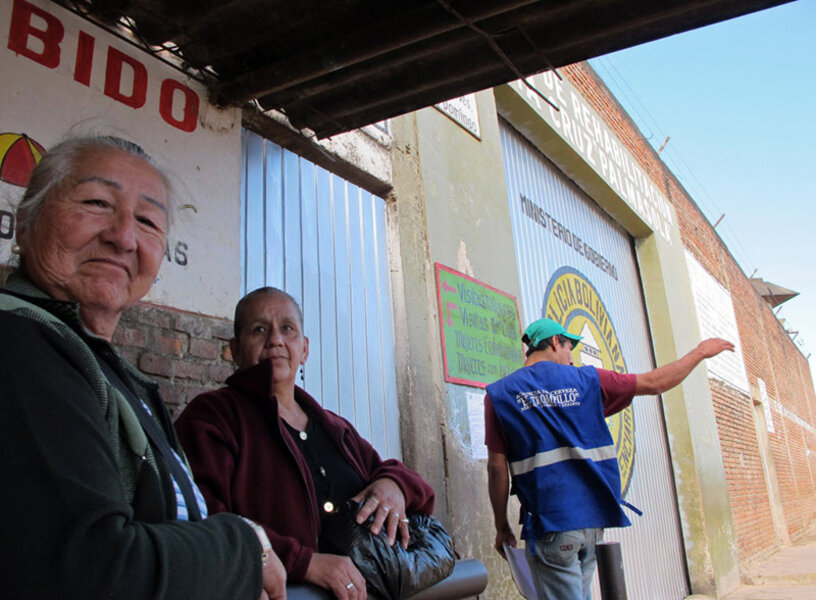Pope Francis visits overcrowded Bolivian prison. How does it compare on a global scale?
Pope Francis visited one of Bolivia’s many overcrowded prisons on Friday.
The New York Times reports the facility, called Palmasola, is built for 800 people but houses 5,000 instead.
This is not an anomaly. Bolivia has a prison population of almost 15,000, living in facilities intended to fit between 5,000 and 5,750.
The pope has made a sustained commitment to connect with the incarcerated. Last March, he washed the feet of 12 inmates in a Rome prison on Holy Thursday. Friday, he set out to lead prisoners in prayer and hear testimonies.
The Palmasola premises also includes more than a dozen restaurants, several churches and vendors that sell groceries and handicrafts, according to The Wall Street Journal.
But what it provides in facilities, it lacks in essential care.
Leónidas Rodríguez, a prisoner elected by inmates to serve as the main ward’s de facto manager, told The Wall Street Journal there are only two doctors for the entire prison population and no ambulance service, which has led to scores of deaths from illnesses like tuberculosis and drug overdose.
Penal Reform International notes countries have an obligation to protect the lives of people in custody, which includes a commitment to ensure adequate hygiene and healthcare.
So how do Bolivia’s prisons compare to those around the world?
In Time’s list of the 10 worst countries for prison overcrowding, Bolivia is sixth with 269.8 percent occupancy. Haiti leads with 335.7 percent. The United States falls just under 100 percent capacity and is below the top 100 worst ranking countries.
However, the US incarcerates the highest proportion of its population.
A report by The International Centre for Prison Studies found 716 out of every 100,000 American citizens are prisoners, about five times of the world’s average prison population rate.
The US's low ranking on Time’s list may be influenced by the burgeoning prison industry.
An infographic featured on Truthout finds the number of privately operated prisons in the US has increased 1,600 percent between 1990 and 2010. It also notes the industry brings in about $3 billion in annual revenue and provides cheap labor to big corporations with wages as low as $0.93.
The prison studies report found almost half of the world’s prisoners reside in China, Russia and the US – three countries which account for just over a quarter of the world’s population.
It also noted the world’s prison population has grown by 25 to 30 percent – the increase is evident on every continent. This trend is, however, accompanied by a total population growth of more than 20 percent.
Scandinavian countries take a radically different approach to the US and Bolivia when it comes to prison conditions.
Unlike Bolivia, its occupancy level is only 97 percent.
Those behind bars often live like regular citizens – even if they are in prison for offenses like murder or drug trafficking.
An article in The Atlantic magazine says some rooms in Nordic prisons resemble college dorms and may include flat-screen TVs. Prisoners may also eat in dining halls with staff and are not required to wear a uniform.
The article finds even in Scandinavia’s high-security prisons, inmates may have access to table tennis, pool tables, and aquariums.
It attributes this phenomenon to three key factors. First, criminologists have more influence over criminal justice policy than politicians. Second, Scandinavia has a record of the best social service networks in the world. Third: Scandinavia has a relatively low prison population – the prison population of Sweden (6,900) is less than half the population of New York City's Rikers Island at its height (14,000).
The average Norwegian prisoner is only between one-half to one-third times likely to return to prison than the average American offender.
Norwegian Governor Arne Nilsen, a clinical psychologist by profession, told The Guardian the reasoning behind their treatment of prisoners.
“The punishment is that you lose your freedom. If we treat people like animals when they are in prison they are likely to behave like animals.[…]It is important that when they are released they are less likely to commit more crimes. That is justice for society”








